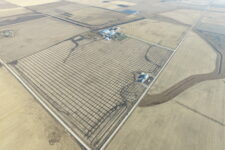Plant roots suffer when your soil contains excess water. In many cases, the excess causes the plant to drown. Other times, extra water causes disease and stunted growth. Efficient farm drainage keeps these disasters at bay. Field tiling protects your plants and your future.
At Luft and Sons, we aim to fully educate farmers on how drainage tiling works. Visualizing the effects of drainage solutions can be challenging, so let’s compare farm tiling to flower pots. Before we start, remember that they put holes in flower pots for a reason!
The Science of Soil Drainage: Protecting Your Crops and Future
Imagine 5 flower pots on your porch. The first pot has no holes, the second pot has 1 hole, the third pot has 2 holes, and so on. Now, imagine each plant gets a good 1 inch of rain. What’s going to happen to each plant?
The plant in the first pot will drown. The second plant will live but produce little to no yield. The 5th pot will yield the most and outperform the rest. Drainage tile creates the same conditions as the fifth pot and effectively drains excess moisture to optimize crop yields.
Ground temperature is another consideration for optimizing your land. Plants, like all living organisms, perform best in certain temperatures. Most plants prefer warmer soil. Moderately warm temperatures stimulate root growth and increase the plant’s metabolic processing.

The Crucial Role of Ground Temperature and Early Planting
Every spring, snow melts throughout your fields. The melted snow creates millions of gallons of water. Your ground soaks up all this barely-above-freezing, 33-degree water. Keep in mind that planting in cold soil stunts root development and long-term growth.
So, let’s take those aforementioned flower pots, give them another good inch of rain, and place them in the freezer overnight. The next day, let’s set them outside in the sunlight. What’s going to happen?
The pot with no holes has no way to release the cold water. The lack of drainage traps the cold water, and the soil will not warm up. As the first pot struggles, the 5th pot is already getting warm. A pattern-tiled farm will send cold water straight to the creeks and rivers, allowing the ground temperature to rise quickly. This process lets you begin farming sooner while taking advantage of an earlier planting window.
Raising the ground temperature and lowering the water table in early spring is critical for healthy root development. Roots are the foundation of plant structure. They develop in the first few stages of growth and affect the plant’s lifetime development.
Maximizing Farm Profitability with Effective Tiling
A lower water table provides exceptional growing conditions to young plants and allows them to grow a more extensive root structure. This root structure ensures you’ll have a much healthier plant when the ground dries up in the summer. The plant will have a deeper root system capable of pulling moisture from far below the surface.
Additionally, tiling protects your farm during rainy periods. Waterlogged soil deprives plants of oxygen essential for their growth and nutrient uptake. Crops suffocate and suffer from reduced yields without proper drainage systems in place.
Drown-outs are common during heavy rains. Even a good outlet in the center of your low areas doesn’t eliminate drowning risks. When the ground reaches its saturation point, rainwater accumulates at ground level and collects at the lowest point of the field. Then, it will flow down any available inlet pipes.
On occasion, even large outlets can’t remove the water fast enough. Water will drain at the surface, but the ground around the outlet will remain oversaturated. This oversaturation disrupts the root system and consequently kills the plant.
A properly tiled farm gives the ground 3-3.5 feet of non-saturated soil ready to soak up rain. If it continues raining, the inlet will do its job as the underlying tile takes excess water away. This process keeps plants from drowning. As a bonus, well-drained soil makes it easier to harvest crops and keeps machinery from getting stuck in muddy fields.
Oversaturated fields cause long-term damage, too. Excessive water hinders a plant’s ability to withstand extreme weather conditions. Waterlogging stresses plants, making roots less resilient to further environmental challenges. Adequate drainage maintains a healthier root system, allowing plants to cope with future weather fluctuations.
Tiling is a one-time investment that improves the profitability of your land. Luft and Sons has been providing drainage solutions to northwest Iowa since 1948. We are your drainage and tiling experts. Our team has the technology to optimize your land now—and for future generations. Contact us for a free land assessment and consultation.


